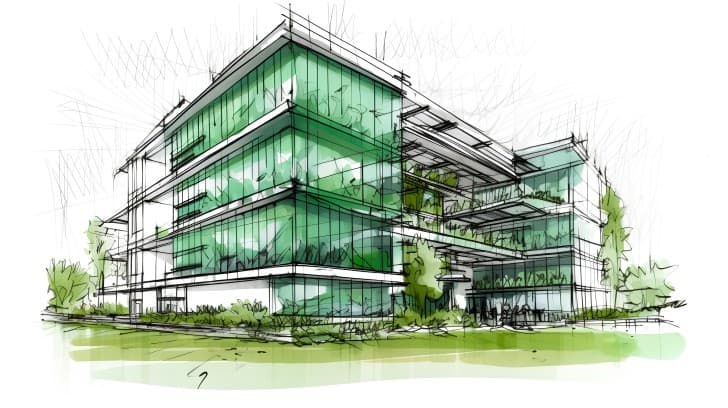Behind ESG - Part 1: "E" - Environmental

31.
May 2023
Three letters have long been widely known in the real estate industry: ESG. This abbreviation stands for Environmental, Social and Governance. Translated somewhat loosely into German, it refers to environmental and social aspects as well as issues of responsible corporate governance. Or, to put it another way, environmental and social sustainability. For a long time now, the "E" in ESG in particular has been at the forefront of numerous discussions, decisions and questions relating to the development of new real estate projects, the refurbishment of existing properties and investment criteria. The "S" and "G" aspects are also important, but tend to fall by the wayside. In this blog post, we present all of these individual points in more detail and address their relevance for the real estate industry and specifically also for residential property owners.
ESG and sustainability
Treating the earth as gently as possible - that's probably what most people think of when they hear the term "sustainability". And, of course, ecological aspects are important: after all, climate change has been increasingly noticeable in Germany and the rest of Europe for some years now - just think of the 2021 floods in the Ahr Valley or the droughts in southern Europe in the summer of 2022.
But ecological aspects have long been linked to economic ones as well. Those who use existing resources as efficiently as possible not only save emissions, but also cash. Added to this are the ever stricter regulations from the federal government and the EU. Companies that want to position themselves for the future can no longer avoid more sustainable business practices. Private homeowners can save money in the long term by making major investments in the here and now - for example, by purchasing a photovoltaic system to generate green electricity.

"E" for Environmental
The "E" for Environmental in ESG includes measures to protect the environment and climate, the use of renewable energies, the reduction of emissions and the conscious use of the planet's limited resources. If a company wants to score points in terms of environmental friendliness, it must, for example, take measures to mitigate climate change, have the smallest possible CO2 footprint, rely on wind and solar energy, protect natural resources along the value chain, or use the shortest possible delivery routes in logistics.
Reducing emissions is certainly one of the most important aspects when it comes to environmental friendliness and sustainability. This applies to companies as well as to private homeowners. This step toward reduced CO2 emissions is also known as decarbonization of the building sector. By making an effort to reduce emissions, companies secure a more solid investor base and can burnish their image. Private owners can save money in the long term by making their property climate-neutral as early as possible, for example by generating their own electricity using a solar system or by reducing their heating bills thanks to the installation of a modern heat pump. For both groups, this means that they will avoid fines in the future, which the EU is already planning for buildings that are particularly poor in terms of energy efficiency.
ESG and the future value of real estate
One of the key implications for both private and commercial property owners is that the value of a property will be significantly influenced in the future by the extent to which it meets modern ESG requirements. These include good energy efficiency and insulation, emission-free energy generation thanks to solar systems, and environmentally friendly heat generation using a heat pump.
To demonstrate such ESG compliance, there are so-called sustainability certificates. The most common certificates on the German real estate market are the U.S. LEED (Leadership in Energy and Environmental Design), the British BREEAM (Building Research Establishment Environmental Assessment Method) and the German DGNB seal (Deutsches Gütesiegel Nachhaltiges Bauen).
To receive such a seal, a property must meet points in various categories. Depending on how "green" a building is, it receives a certificate at different rating levels, usually divided similarly to Olympic medals: Bronze, Silver and Gold. In addition, there is platinum, for which, however, a building must meet the highest standards.

Such "green buildings" are likely to become more and more prevalent on the market. Institutional investors, for example, already invest their capital almost exclusively in so-called Article 8 or Article 9 funds. These are funds that place particular emphasis on ESG aspects in their investment criteria. In addition, sustainably certified buildings generally achieve higher sales prices, can be marketed more easily, and are also good for a company's image. Private owners need to keep this in mind especially if they want to sell their property in the future and possibly move, or if they own several properties as an investment. Buildings with a poor energy balance will lose a lot of value in the future and may not be able to be sold at all sooner or later.
Subsidies and regulations
ESG compliance is no longer optional for real estate companies and owners, but mandatory. This is ensured not only by the requirements of the market and the demands of real estate buyers, but also by increasingly strict regulations from the federal government and the EU. For some time now, these have prescribed certain emission targets, compliance with which is monitored by means of emission certificates, for example. On January 1, 2023, a number of new laws came into force that impose further obligations on real estate owners.
One of the most important is certainly the revised Building Energy Act (GEG). This now prescribes the strict energy standard EH-55 for new buildings and old buildings after renovation. In simplified terms, this means that a house may only have 55 percent of the primary energy requirement of a reference house in order to meet this standard. This new regulation affects residential buildings as well as commercial properties. Regulations are also becoming increasingly stringent at the EU level. For example, the "nearly zero-energy house" has been the standard for new buildings since 2021. Non-residential buildings in public ownership have already had to comply with these requirements since 2019. The aim of the new GEG is also to transform EU directives into national law.

Wherever the state imposes stricter requirements, it generally also provides support measures. In Germany, for example, this is done via the KfW development bank. One of the latest subsidies is the "Climate-friendly building" subsidy guideline. This has been in force since March 1, 2023, and provides funding for new buildings that meet particularly ambitious sustainability targets. Those that meet these requirements receive the government's Sustainable Building Quality Seal (QNG). The aim is to reduce greenhouse gas emissions from construction to demolition. Likewise, fewer resources, land and energy are to be consumed, and the recycling of building materials is to be facilitated.
In order to drive forward the energy turnaround, the federal government has now also declared war on gas heating. In return, the installation of heat pumps is being promoted, and the installation of a photovoltaic system is set to become increasingly attractive for private homeowners. Recently, no value-added tax has been charged on the purchase, and those who only want to operate a smaller system are even exempt from income tax.
More sustainability in leasing thanks to "green" leases
While the green building certificates already mentioned often only look at how climate-friendly a building is constructed, the use of a property is also of decisive importance for its actual climate footprint. If the industry really wants to become climate neutral, it must also pay attention to emissions between construction and demolition and keep them as low as possible.
To achieve this, there are now so-called green leases. In such green leases, both tenants and owners are usually obligated to use the building as sustainably as possible. Tenants can be encouraged to use as little energy and water as possible, to produce as little waste as possible and to recycle better, and to use the building or apartment in an environmentally conscious way.

Since every building is different, each contract must also be drawn up individually - there is no one green lease that fits all properties and all situations. For new buildings, the option of a green lease agreement can already be taken into account in the planning stage. This offers the most scope for energy-saving measures in the long term. However, green leases bring not only ecological but also economic advantages. Because if a building is used in a water- and energy-saving way, tenants as well as owners can save costs.